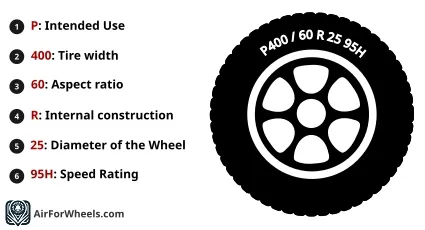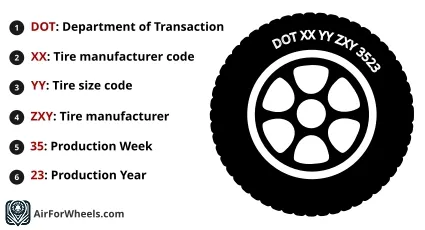Tire size conversion calculator
Use the calculator bellow to convert tire size from metric to inches or inches to metric:
Convert Metric Tire size to Inches
Dimension Label | Name | Inches | Milimeters |
|---|
How to convert tire size from metric to inches
To convert 250/60R25 tire size to inches following these steps:
- Convert tire width from milimeters to inches: 250 / 25.4 = 9.84"
- Calculate sidewall height by multiplying tire width by aspect ratio: 250 * (0.6) = 150mm
- Convert sidewall height from milimeters to inches: 150 / 25.4 = 5.91"
- Calculate tire diameter in inches: (5.91 * 2) + 25 = 36.82"
- Now you have calculated all free components which tire size code in inches is made of:
- Tire Diameter (36.82)
- Tire width (section width) (9.84)
- Rim diameter (25)
- Converted tire size code 250/60R25 in inches is: 36.82x9.84R25
Tire codes explained

Intended Use
The first part of the tire code consists of one or two letters (P, LT, ST, T) that indicate the type of vehicle the tire is designed for. Here's a quick rundown:
- P (Passenger Car): These tires are meant for cars, SUVs, crossovers, minivans, and smaller pickup trucks. They offer a comfortable ride and are optimized for everyday driving.
- LT (Light Truck): Designed for heavier loads and towing, LT tires are suitable for larger trucks and vehicles that need to haul or tow.
- ST (Special Trailer): These tires are used for trailers, including boat trailers, utility trailers, and travel trailers. They are built to handle the specific demands of towing.
- T (Temporary): Usually spare tires, these are not intended for regular use. They are designed to get you to a service station in the event of a flat.
Nominal Section Width
The second part of the code is a three-digit number representing the tire's nominal section width in millimeters (mm). This is the widest point of the tire, measured from sidewall to sidewall. For example, in a tire code "215/65R16", the "215" indicates the tire is 215 mm wide.
Aspect Ratio
Following the nominal section width is the aspect ratio, displayed as a two- or three-digit number after a forward slash (/). This ratio compares the tire's section height to its width. A tire marked "215/65R16" has an aspect ratio of 65, meaning the height is 65% of the tire's width. For instance, if the width is 200 mm, an aspect ratio of 65 means the section height is 130 mm.
Internal Construction
The next part of the code indicates the tire's internal construction with a single letter (R, D, B). This detail is crucial for understanding the tire's strength and durability:
- R (Radial): Almost all passenger cars use radial tires, where the cords run perpendicular to the direction of travel. Radial construction provides flexibility and a smoother ride.
- D (Diagonal): In diagonal or bias-ply tires, cords run at a 30-40° angle, crisscrossing over each other. These are less common in passenger vehicles but used in some trucks and specialty applications.
- B (Bias-Belted): Similar to diagonal tires but with additional stabilizer belts. This construction provides extra support and stiffness, improving load capacity and durability.
Diameter of the Wheel
The diameter of the wheel is specified next, usually as a one- or two-digit number indicating the size of the wheel in inches. In our example "215/65R16", the "16" signifies that the tire fits a 16-inch wheel. Ensuring the correct wheel diameter is vital for proper tire fit and vehicle performance.
Load Index
The load index is a two- or three-digit number that tells you the maximum weight the tire can support when properly inflated. For instance, a load index of 95 means the tire can carry up to 1,520 pounds (690 kg) at a specified pressure. This information helps ensure your tires can handle the weight of your vehicle and any additional load.
Load-Carrying Capacity IndexLoad indexLoad in pounds (lbs)Load in kilograms (kg)Speed Rating
The speed rating is the final part of the main tire code, represented by a letter or a combination of a digit and a letter. This rating indicates the maximum speed the tire can safely sustain. For example, a tire with a speed rating of "H" can safely travel up to 130 mph (210 km/h). Matching your tire's speed rating to your driving habits and vehicle specifications is essential for safety and performance.
Speed index chartSpeed ratingMaximum speed km/hMaximum speed mphDOT Code
In addition to the main tire code, U.S. tires also feature a DOT code, mandated by the Department of Transportation. This code provides details about the tire's manufacturer, production plant, batch, mold, and the date of production. The last four digits of the DOT code are especially important, indicating the week and year the tire was made (e.g., "1321" means the 13th week of 2021). Tires older than ten years should generally be replaced, regardless of their apparent condition, due to material aging. The NHTSA recommends replacing tires every six years for optimal safety.
